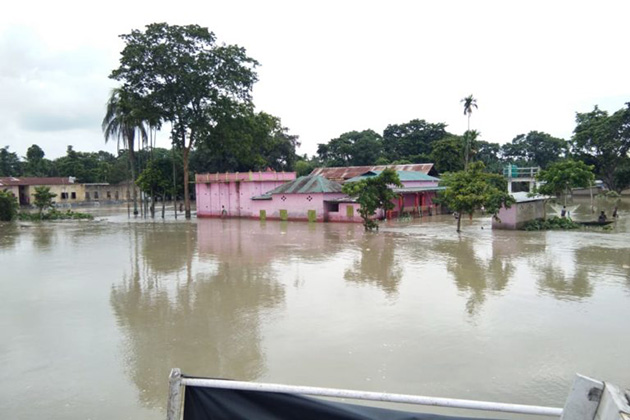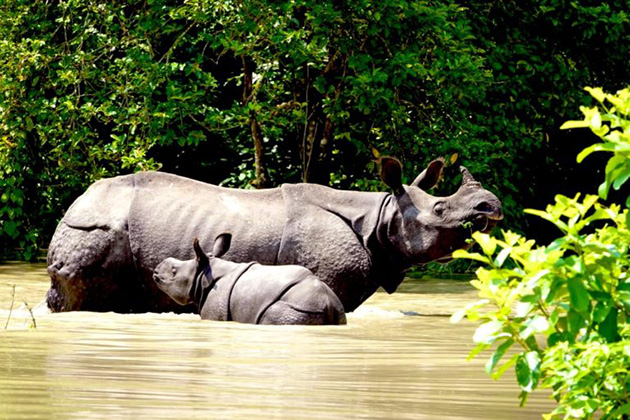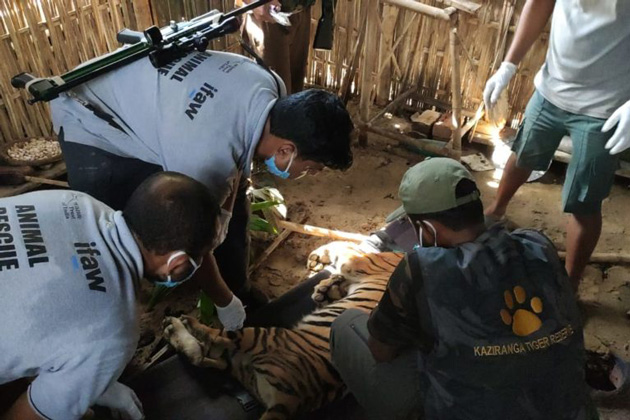Assam reels under flood as pandemic wears on
- Floods which are a recurring phenomenon in the northeast Indian state of Assam have hit the state heavily this year but healthcare workers have risen to the occasion serving the people by battling both flood and novel coronavirus disease (COVID-19) pandemic.

- Around 2.9 million (29 lakh) people from 26 districts in Assam have been affected by floods in the state this year. As many as 93 have died and the deluge has led to massive infrastructure, livestock and crop losses.
- The state disaster management authority has released standard guidelines to maintain social distancing in the flood relief camps amid an uptick in COVID-19 cases in Assam.
- This year’s flood is the sixth heaviest in the history of Kaziranga and has killed 153 wild animals so far, including 12 rhinos. Protected forests like Orang and Pobitora have also been affected by the deluge.
Floods which are a recurring phenomenon in the northeast Indian state of Assam have hit the state heavily this year but healthcare workers have risen to the occasion serving the people by battling both flood and novel coronavirus disease (COVID-19) pandemic.
The floods have affected around 2.9 million (29 lakh) people across 26 districts covering about 80 percent of Assam’s total area (till July 24). As many as 103 people have died and the state is staring at massive crops, livestock, and infrastructure losses.
The challenge before the government and people of Assam this year is acute because of the ongoing COVID-19 pandemic that has affected over 30,000 people in the state so far while 88 people have died from the viral disease.

Irrespective of inundation-related challenges, healthcare workers are wading through floodwaters to check on people stranded in submerged villages while others are working feverishly in relief camps even as convincing those affected to take refuge in relief camps becomes an additional challenge.
Bonti Pothari, an Accredited Social Health Activist (ASHA) worker from Missamora in Majuli district observed that this year’s flood is more severe than last year. “Many people in our area have not gone to relief camps despite their villages getting inundated. They are not ready to leave their livestock behind which is their main asset. We visit those places on boats and supply people with medicines,” she said.
Many are also not going to relief camps because of the pandemic. The state has set up over 450 relief camps where over 45,000 people are sheltering. Dhira Baishya, ASHA supervisor from Matia in Goalpara district said: “Though there is no active COVID-19 case in my area at present, many people from the flood-affected villages here are not coming to the relief camp this year.”
The real challenge for healthcare workers comes after the floodwaters start receding and waterborne diseases take over. Baishya said “To make matters worse, skin diseases are seen among the flood victims. So we need to be vigilant against those.”
With the threat of transmission of COVID-19 looming large in the flood relief camps, rapid testing is being done in camps where adequate social distancing may not be possible due to the circumstances. Achyot Jyoti Das, who works as a lab technician in the Centre for North East Studies and Policy Research (C-NES) run boat clinic in Jorhat, has been currently engaged by Majuli district administration for the collection of swab samples of inhabitants of relief camps in the district.
Das told Mongabay-India, “We do the Rapid Antigen Detection (RAD) test first whose results are made available within an hour. Then we also collect the swab samples for the reverse transcription-polymerase chain reaction (RT-PCR) which are sent to the laboratory in Jorhat for testing. The result generally comes after three-four days.”
“However, in the relief camps, rapid tests haven’t detected any positive cases so far. The report for the lab test will come after three days. The relief camps are being set up mainly in schools. Each camp houses 8-9 families. If someone is found positive in these camps, then it will be declared as containment zone.”
Das informed that the lab technicians collecting samples have been provided with proper Personal Protective Equipment kits. He said that during monsoon, connectivity becomes the main issue in Majuli, which is a river island. “We are using boats as our main mode of transport. It is very distressing to see the kind of loss poor people have endured this time. The flood struck just before the harvesting of crops leading to a huge loss. A lot of livestock has been affected as well which is one of the sources of the major income for the rural population on the island,” he said.
Dealing with COVID-19 strengthens flood preparedness
Despite the dual challenges of flood and COVID-19, a section of government officials feels that battling the pandemic since the last four months has prepared them for this challenge.
Ranjan Sarma, deputy commissioner, Baksa district told Mongabay-India, “We already put measures in place to fight the pandemic. We brought people, especially migrant returnees directly from the railway stations to the screening centres where their swab sample was collected. We have got 2030 people in seven relief camps. We are trying to maintain social distancing in the camps though, in these camps, there is crowding at times. However, we have got medical teams to monitor the situation.”
Sarma mentioned that another wave of the flood might be coming soon. “Puthimari river embankment has been breached in four areas. We have asked the Public Works Department (PWD) and Water Resource Department to take preventive measures. We are hoping that water discharge from rivers will go down because otherwise, it will be difficult for the concerned departments to take necessary measures,” he said.
Anant Lal Gyani, deputy commissioner of flood-affected Dhubri district said that the fear of contracting disease has discouraged people from coming to the relief camps.“This time, the number of people coming to stay in the camps is very low because of the COVID-19 pandemic. Right now, we have 161 active cases in the district. I will say the situation is under control at present in the district. Our healthcare workers are visiting the flood-affected villages. We are distributing relief to people who are not living in relief camps through relief distribution centres” said Gyani.
Assam State Disaster Management Authority (ASDMA) had issued a Standard Operating Procedure (SOP) on relief camp management in the wake of the pandemic.
Kripaljyoti Mazumdar, Project Officer at ASDMA said officials are trying to ensure as per seven square metre area per person in the relief camps as per the SOP as against 3.5 square metres necessitated earlier.
“We have got handwashing, proper toilet and sanitation facilities in place in the camps. Everyone is being screened for COVID-19. We have marked these camps as no-spitting and no-tobacco zone. There is child-friendly space in the camps. Our health team is monitoring these camps daily. Till now, there is no report of community transmission in any camp.” Mazumdar said though this year’s flood is severe, prior preparation has helped in managing the situation well. ”
“We have got volunteers like Pratirodhi Bondhus who have helped our responding agencies like National Disaster Response Authority (NDRF) and State Disaster Response Authority (SDRF) in rescues. We have also engaged them in camp management and relief distribution. We have also got e-help desks to provide non-emergency medical help to the inmates if needed,” he said.
However, the floods have disrupted the ongoing repair work at Baghjan where an oil well blowout resulted in a major fire that has been raging since June 9.
Tryst of wild animals with the flood
Not just humans, the impact of the flood of wild animals is also significant. Kaziranga National Park & Tiger Reserve (KNP/KTR), a World Heritage Site is reeling from two waves of flood which is considered necessary for the smooth functioning of its ecology and grasslands.
As per the latest report from the KNP authorities, 85 percent of the park is submerged and 135 out of 223 forest camps are inundated. 153 wild animals have been rescued so far in the flood while 125 animals including 93 hog deers, 12 rhinos, five wild buffaloes, eight wild boars, two swamp deers, one sambar, three porcupines, and one python have been the casualties of this flood.

Park director P Siva Kumar said this year’s deluge as the sixth heaviest in the park’s history and warned of more animal casualties. “Last year’s flood was even worse. It was the third-worst flood KNP faced since 1988 which is called the worst flood ever in the history of the park. Another wave of flood might come as monsoon here continues till September.”
“The water level is rising every day and we might see more animal casualties in the coming days. The frequency of floods is a cause of concern. Earlier, we used to face major floods once in 8-10 years. But in the last four years, we have faced three big floods,” he said.
Two other important protected forests of Assam, Pobitora, and Orang are also grappling with floods. Pobitora Wildlife Sanctuary, known for having the highest density of one-horned rhino is located in the flood-hit Morigaon district.
Floods prompt wild animals to look for highlands and they often stray into human habitations for refuge. These animals are then rescued by the forest department with help from Wildlife Trust of India (WTI) run Centre for Wildlife Rehabilitation and Conservation (CWRC).
Recently the team ensured a safe passage back into the forest for a tiger that had taken shelter in a goat shed in Kandhulimari village near Agoratoli range. In another incident, the veterinarians from CWRC tranquilised a sub-adult tigress which was stranded in the residence of one Prabin Bora from Baghmari village in Bagori and released it later in the jungle. In this year’s flood, four tigers have been rescued so far apart from two rhinos, four turtles, 115 hog deers, and 21 pythons.

Mukul Tamuly, range officer, Pobitora Wildlife Sanctuary said the water this time has brought silt with it. “As a layer of silt covers the grass, it makes it difficult for the herbivores to eat those. A female aged rhino has died in the flood in Pobitora. We have a 2 km long road cum highland which is being used by animals like rhinos, buffaloes, wild boars, and jackals. We also have six platforms that have become old and so were of not much help this time. Out of our 24 camps, 16 have been submerged. From four of those, we had to evacuate our staff. Till now, they haven’t been able to go back to those camps.”
Orang National Park, which has a high density of rhino and tigers, is in a comparatively better position. Sandeep Bendi, divisional forest officer (DFO), Mangaldai Wildlife Division under whose jurisdiction Orang falls said, “We have faced two flood waves till now. Three hog deers have perished from the flood so far. 28 out of 40 camps are submerged currently. Right now, 50 percent of the park is submerged. 30 percent area of the park is a natural highland where most animals take shelter. Some animals like rhinos and tigers sometimes move to the nearby riverine islands looking for refuge. We try to monitor their activities.”
Calamity in other northeastern states
Not just Assam, other northeastern states are also bearing the wrath of nature this monsoon. Five people were killed and over a lakh were affected in the West Garo Hills district of Meghalaya after the area witnessed a surge in water level last week. 175 villages have been affected by the flood and the district administration and 22 relief camps have been opened for the affected population. On the other hand, Arunachal Pradesh witnessed severe landslides in July which killed eight people. In June, severe flash floods triggered by heavy rainfall damaged 19 houses and an old hostel of a senior secondary school in Upper Djongu region of North Sikkim district in Sikkim.
This article first appeared on Mongabay.







